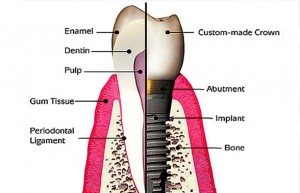 Many of our patients are excited about the opportunity to replace a missing or broken tooth with a “new tooth”. Losing a tooth can impact you in a number of ways ranging from an embarrassing space in the mouth to difficulty chewing. There are a number of options when a patient is choosing to replace a tooth. One very popular choice is the placement of a dental implant.
Many of our patients are excited about the opportunity to replace a missing or broken tooth with a “new tooth”. Losing a tooth can impact you in a number of ways ranging from an embarrassing space in the mouth to difficulty chewing. There are a number of options when a patient is choosing to replace a tooth. One very popular choice is the placement of a dental implant.
The Tooth:
To understand a dental implant, one must first understand the simple anatomy of a tooth. Our teeth consist of 2 parts: Crown (the part you can see when you smile) and Root (the part beneath the gum that anchors the entire tooth in bone). The tooth itself is not actually fused to the surrounding bone, but is attached via small ligaments. These ligaments act as a shock absorber for the teeth during chewing and function. A nerve lives inside the tooth that helps sense temperature changes. In addition, the outer part of the crown has enamel which helps resist decay that leads to cavities.
The Implant:
A dental implant is simply a “root replacement”. When a tooth is removed, a socket in the bone exists where the root used to live. A new root (the dental implant) can be placed in the site. The implant is shaped like the root of a tooth and is made of surgical grade titanium (similar to those used in many hip and knee replacements). It is set in the socket below the gum line and is not visible in the mouth. Once placed in the site, the implant and bone fuse together (this typically occurs 95+% of the time). A number of health issues or habits, such as smoking and diabetes, can alter this success rate. Since the implant itself is made of titanium, no decay can occur. In addition, the need for any future root canals is eliminated.
Once the implant has healed and fused to the bone, the dentist can proceed with making the crown that will be attached to this new “root”. Continued check-ups are needed to be sure the implant and surrounding gum and bone tissues remain heathy.
Dental implants have become a very straight forward way for a tooth to be replaced in a fashion that provides a replacement that is almost exactly like the tooth that has been lost. It is important to note that every patient has a different set of needs and circumstances. Evaluation by your dental surgeon can help determine what options are best for you. Typically this examination will include the use of a 3D x-ray to help determine the jaw bone available and the safest options in each individual case.
Lee R. Cohen, D.D.S., M.S., M.S.
4520 Donald Ross Road, Suite 110
Palm Beach Gardens, FL 33418
Phone: 561-691-0020
www.pbcperio.com
Check Also
Physical Therapy for the Brain
Have you noticed you have difficulty hearing your family and friends in a noisy restaurant? …
 South Florida Health and Wellness Magazine Health and Wellness Articles
South Florida Health and Wellness Magazine Health and Wellness Articles




